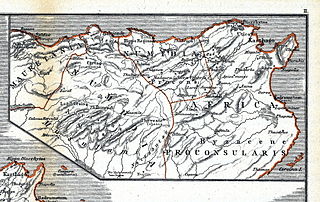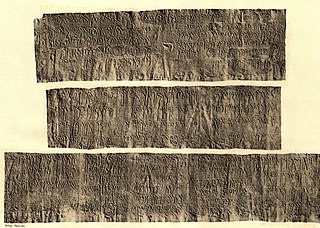Related Research Articles

Almost all Roman roads in Africa were built in the first two centuries AD. In 14 AD Legio III Augusta completed a road from Tacape to Ammaedara: the first Roman road in Africa. In 42 AD, the kingdom of Mauretania was annexed by Rome. Emperor Claudius then restored and widened a Carthaginian trail and extended it west and east. This way the Romans created a continuous coastal highway stretching for 2,100 miles from the Atlantic to the Nile. In 137, Hadrian built the Via Hadriana in the eastern desert of Egypt. It ran from Antinoopolis to Berenice.
M'chira is a small village in Algeria, north east of Algiers.
Noël Duval was a French archaeologist.
Jules François Toutain was a French archeologist.
Eugène Albertini was a 20th-century French teacher in Latin literature, a historian of ancient Rome, especially for North Africa and an epigrapher of Latin texts. He was a member of the Académie des inscriptions et belles-lettres (1938).
Louis Demaison was a 19th–20th-century French historiographer, archaeologist, and with Henri Jadart, one of the most significant contributors to the nineteenth/twentieth history of the Marne department.

Henchir-Loulou a locality and archaeology site near the modern town of Aïn Makhlouf, Algeria. It is the site of an ancient Roman Era town.
Auguste Audollent was a French historian, archaeologist and Latin epigrapher, specialist of ancient Rome, in particular the magical inscriptions. His main thesis was devoted to Roman Carthage.
Pierre Salama was a French historian and archaeologist, specialist of Roman roads in Africa as well as milestones. An epigrapher, numismatist, he was also a specialist of historical geography.
Marcel Le Glay was a 20th-century French historian and archaeologist, specializing in ancient Rome. His work focused in particular on Roman religion and North Africa during Antiquity, especially from Latin literature epigraphic: his monumental thesis, dedicated to the cult of Saturn in Africa, is meeting his three favorite areas.
Jehan Desanges was a French historian, philologist and epigrapher, a specialist in the topic of North Africa during Antiquity.
Claude Lepelley was a 20th-21st-century French historian, a specialist of late Antiquity and North Africa during Antiquity. His thesis, Les cités de l'Afrique romaine au Bas-Empire, defended in 1977 under the direction of William Seston, profoundly changed the understanding of the urban world in the 3rd and 4th centuries; far from declining, the cities of Africa had some prosperity.

Abbir Germaniciana also known as Abir Cella is the name of a Roman and Byzantine-era city in the Roman province of Africa proconsularis. The city was also the seat of a bishopric, in the ecclesiastical province of Carthage, and is best known as the home town of the Pre Nicaean father, Cyprian, who was bishop of Abbir Germaniciana around 250AD.

Tubusuctu also known as Colonia Iulia Augusta Legionis VII, was a Roman colony founded by Augustus for military veterans and known for its olive oil.

Marazanae was a Roman town of the Roman province of Byzacena during the Roman Empire and into late antiquity.
Ksour-el-Maïete is a set of ruins in Tunisia near the Cherita and the Sebkhet de Sidi El Hani lakes.
Bir el Menadla is a locality and archaeological site in Governorate de Mahdia, Tunisia.
Naïdé Ferchiou was a Tunisian archaeologist whose work dealt mainly with Roman North Africa. She excavated at several important sites, including Abthugni.

Numidia was a Roman province on the North African coast, comprising roughly the territory of north-east Algeria.

The Maktar and Mididi inscriptions are a number of Punic language inscriptions, found in the 1890s at Maktar and Mididi, Tunisia. A number of the most notable inscriptions have been collected in Kanaanäische und Aramäische Inschriften, and are known as are known as KAI 145-158.
References
- ↑ Bulletin Archéologique du Comité des travaux historiques Et scientifiques Archived 2017-08-13 at the Wayback Machine (1900) p126.
- ↑ Pierre Salama, Les voies romaines de l'Afrique du Nord, Algiers, 1951.
- ↑ Itinéraire d'Antonin, éd. d'O. Cuntz, Leipzig, 1929 (1990 ISBN 3-519-04273-8).
- ↑ Pierre Salama, Les voies romaines de l'Afrique du Nord, Alger, 1951 (with a map of 1949).
- ↑ Bulletin Archéologique du Comité des travaux historiques Et scientifiques Archived 2017-08-13 at the Wayback Machine (1900) p126.